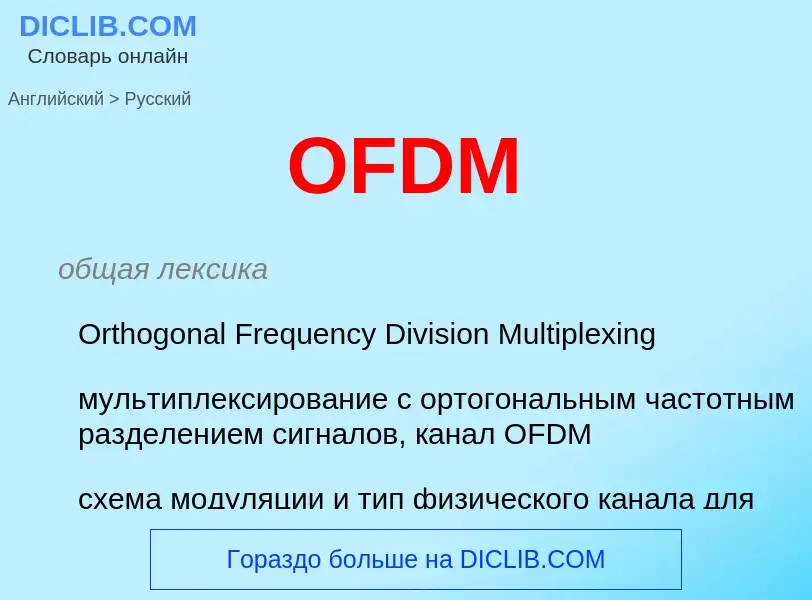ترجمة وتحليل الكلمات عن طريق الذكاء الاصطناعي ChatGPT
في هذه الصفحة يمكنك الحصول على تحليل مفصل لكلمة أو عبارة باستخدام أفضل تقنيات الذكاء الاصطناعي المتوفرة اليوم:
- كيف يتم استخدام الكلمة في اللغة
- تردد الكلمة
- ما إذا كانت الكلمة تستخدم في كثير من الأحيان في اللغة المنطوقة أو المكتوبة
- خيارات الترجمة إلى الروسية أو الإسبانية، على التوالي
- أمثلة على استخدام الكلمة (عدة عبارات مع الترجمة)
- أصل الكلمة
OFDM - ترجمة إلى إنجليزي
общая лексика
Orthogonal Frequency Division Multiplexing
мультиплексирование с ортогональным частотным разделением сигналов, канал OFDM
схема модуляции и тип физического канала для высокоскоростной передачи данных в диапазоне 5 ГГц. Предложена компанией Intersil
Смотрите также
общая лексика
стандарт IEEE 802.11a
стандарт на беспроводные локальные сети для скоростей передачи 6, 9, 12, 18, 24, 36, 48 и 54 Мбит/с и диапазонов частот 5,35-5,51 и 5,725-5,825 ГГц, тип модуляции OFDM. Принят в сентябре 1999 г
ويكيبيديا
In telecommunications, orthogonal frequency-division multiplexing (OFDM) is a type of digital transmission used in digital modulation for encoding digital (binary) data on multiple carrier frequencies. OFDM has developed into a popular scheme for wideband digital communication, used in applications such as digital television and audio broadcasting, DSL internet access, wireless networks, power line networks, and 4G/5G mobile communications.
OFDM is a frequency-division multiplexing (FDM) scheme that was introduced by Robert W. Chang of Bell Labs in 1966. In OFDM, the incoming bitstream representing the data to be sent is divided into multiple streams. Multiple closely spaced orthogonal subcarrier signals with overlapping spectra are transmitted, with each carrier modulated with bits from the incoming stream so multiple bits are being transmitted in parallel. Demodulation is based on fast Fourier transform algorithms. OFDM was improved by Weinstein and Ebert in 1971 with the introduction of a guard interval, providing better orthogonality in transmission channels affected by multipath propagation. Each subcarrier (signal) is modulated with a conventional modulation scheme (such as quadrature amplitude modulation or phase-shift keying) at a low symbol rate. This maintains total data rates similar to conventional single-carrier modulation schemes in the same bandwidth.
The main advantage of OFDM over single-carrier schemes is its ability to cope with severe channel conditions (for example, attenuation of high frequencies in a long copper wire, narrowband interference and frequency-selective fading due to multipath) without the need for complex equalization filters. Channel equalization is simplified because OFDM may be viewed as using many slowly modulated narrowband signals rather than one rapidly modulated wideband signal. The low symbol rate makes the use of a guard interval between symbols affordable, making it possible to eliminate intersymbol interference (ISI) and use echoes and time-spreading (in analog television visible as ghosting and blurring, respectively) to achieve a diversity gain, i.e. a signal-to-noise ratio improvement. This mechanism also facilitates the design of single frequency networks (SFNs) where several adjacent transmitters send the same signal simultaneously at the same frequency, as the signals from multiple distant transmitters may be re-combined constructively, sparing interference of a traditional single-carrier system.
In coded orthogonal frequency-division multiplexing (COFDM), forward error correction (convolutional coding) and time/frequency interleaving are applied to the signal being transmitted. This is done to overcome errors in mobile communication channels affected by multipath propagation and Doppler effects. COFDM was introduced by Alard in 1986 for Digital Audio Broadcasting for Eureka Project 147. In practice, OFDM has become used in combination with such coding and interleaving, so that the terms COFDM and OFDM co-apply to common applications.

![Subcarriers system of OFDM signals after [[FFT]] Subcarriers system of OFDM signals after [[FFT]]](https://commons.wikimedia.org/wiki/Special:FilePath/N-OFDM.jpg?width=200)


